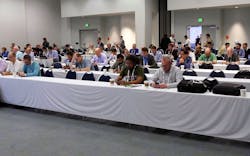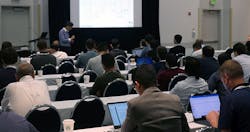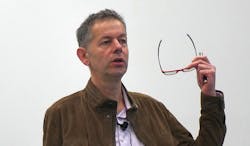The roots of the APEC conference go back to 1975, when a private company put on POWERCON, a show dedicated to the working engineer. When that show ended in 1984, it was replaced by a hodgepodge of tech conferences, but few dedicated to professional engineers.
One of them was APEC, then sponsored by the IEEE Power Electronics Council, formed in 1985. In 1986, the group sponsored the first APEC conference. By 1988, the Council morphed into the IEEE Power Electronics Society (PELS,) an APEC sponsor to this day. In 1990, APEC came into its present form, still sponsored by PELS, but joined by the IEEE Industry Applications Society (IAS) and the Power Sources Manufacturers Association (PSMA). APEC has grown to be the premiere conference for professional power engineers.
This year the conference is held in Anaheim California. The location changes every year, in 2020 it will be in New Orleans. The event is both an educational conference and a vendor show. But in addition to the conference, there was a plenary session Monday that had industry luminaries talk about the future of power electronics. The program notes that the session “designed to cover the history of power, the current needs in energy efficiency, and the future possibilities.” There were five half-hour sessions with questions taken at the end of each.
Topics included an overview of university research by Robert White, chief engineer of Embedded Power Labs, who was representing PSMA. Other plenary sessions included Abas Goodarzi discussing fuel cell engines and Fernando Gómez-Carpintero discussing power electronics used at Airbus for space exploration. He explained the use of gallium nitride (GaN), digital control, and COTS components in spacecraft. The session led off with Peater Wawer of Infineon looking at power electronics in robotics. Another presentation was given by Seth Sanders of Amber Kinetics regarding utility-scale energy storage.
A highlight of the plenary session was Patrizio Vinciarelli receiving the 2019 IEEE William E. Newell power electronics award. Vinciarelli is chairman of the board, president, and chief executive officer of Vicor Corporation, which he founded in 1981. The PSMA also put on two special Saturday sessions: One event was about high-frequency magnetics, while the other focused on capacitor applications using wide-bandgap semiconductors such as GaN and silicon carbide (SiC).
Behind the scenes of the conference and show, there are sponsor meetings for members or IEEE officers (Fig. 3). The IAS has a board meeting all Sunday as well as Monday morning. The PELS has various meetings every day, from Sunday to Friday. These behind-the-scenes meetings are part of the great infrastructure that supports the APEC conference. Membership committees, fellows committees, awards committees, steering committees, all hold meetings to bring together members and officers and keep the organization and event working optimally.
The 18 professional educational seminars at the APEC were held Sunday and Monday. Those sessions had six tracks, components, design, control, high power applications, wide-bandgap, and topology and circuits. The Sunday sessions included a presentation from magnetics guru Ray Ridley on advances in modeling and simulation for magnetics and control. Other presentation involved WBG semiconductors, thermal considerations, digital control, and how to embed passive components in your PCB designs. Robert Pilawa from UC Berkeley gave a presentation on hybrid and resonant converters.
The Sunday seminars included a packed session on magnetics design fundamentals (Fig. 4). The lecturer was George Slama, senior application and content engineer at Wurth Electronics (Fig. 5). The popularity of the presentation shows the hunger power design engineers have for good solid application information on transformers and inductors.
Another packed session was given by Kwok-wai Ma of Infineon explaining the questions you might have when migrating from silicon to SiC transistors in power converters (Fig. 6). Jin Wang of Ohio State University discussed application for wide-bandgap semiconductors for high current power converters (Fig. 7). Lauren Boteler of the U.S. Army Research Laboratory did a popular talk on thermal design considerations for power electronics (Fig. 8).
On Monday, Christophe Basso of ON Semiconductor gave a presentation about simulation as applied to buck topology (Fig. 9). Xuning Zhang from Littelfuse explained how to change your system to accommodate and benefit from SiC (Fig. 10). Other presentations covered motor control, magnetics, reliability, and power-train electronics in vehicles.
The industry and technical sessions as well as the exhibition started on Tuesday. And there are over 500 technical papers in the conference that will be rolled out in dialog sessions on Thursday when the authors will be available to answer questions about their papers.
Note that the “A” in APEC is for “applied.” No one has to sit through presentations on research curiosities like esoteric diamond semiconductors.. APEC is all about circuits and parts that you can put to use today. No matter how versed you are in the circuits and components of power electronics, attending APEC is a smart career move. Whether it is your first time, or if you have gone to every APEC since 1986, there’s plenty to learn.




